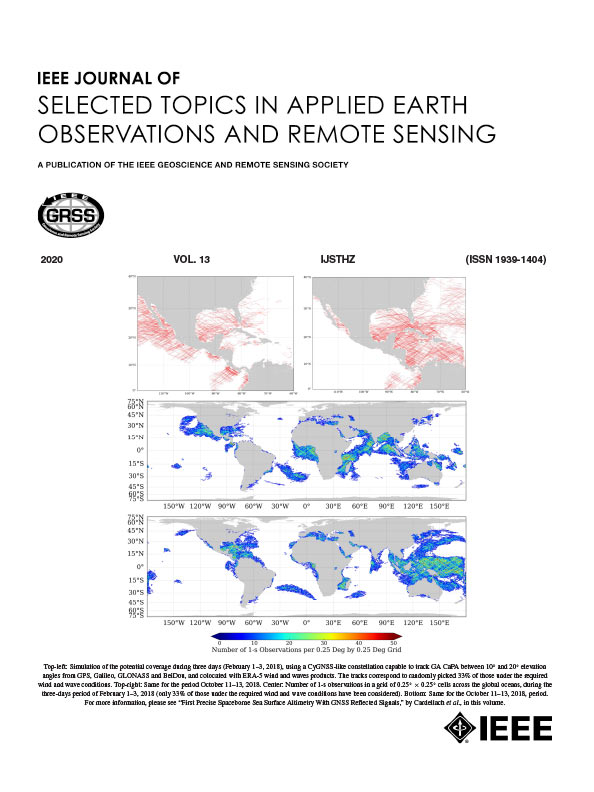基于多方向局部引力和水平线连通性的红外小目标检测
IF 4.7
2区 地球科学
Q1 ENGINEERING, ELECTRICAL & ELECTRONIC
IEEE Journal of Selected Topics in Applied Earth Observations and Remote Sensing
Pub Date : 2025-04-11
DOI:10.1109/JSTARS.2025.3560306
引用次数: 0
摘要
红外小目标检测受到高强度背景边缘残留和低信噪比的严重挑战。这些问题阻碍了从背景中准确区分目标,增加了误报的风险。为了解决这些挑战,我们提出了一种将多向局部引力(LGF)对比与水平线连通性(LLC)对比相结合的方法。LGF模型集成了局部区域内每个像素的信息,并引入了新的sigmoid函数来降低噪声,从而实现了细粒度的梯度检测。这个梯度的大小和方向可以用来区分目标和背景。考虑到目标在不同方向表现出不同的梯度特征,我们进一步提出了多向LGF对比。这种对比度利用LGF大小的分布特性增强目标,有效抑制强边缘。此外,为了充分利用LGF中的方向信息,我们基于目标的空间一致性设计了LLC对比度,增加了目标与背景的差异。最后,我们提出了一种区域融合技术来加权两个对比度,在保持目标强度的同时改善背景抑制。实验结果证明了该方法在高强度边缘背景、复杂纹理和噪声环境下检测目标的有效性。与其他最先进的方法相比,我们的方法显著提高了检测精度。本文章由计算机程序翻译,如有差异,请以英文原文为准。
Infrared Small Target Detection via Multidirectional Local Gravitational Force and Level-Line Connectivity
Infrared small target detection is significantly challenged by residual high-intensity background edges and a low signal-to-noise ratio. These issues hinder accurate target differentiation from the background and heighten the risk of false alarms. To address these challenges, we propose a method that employs multidirectional local gravitational force (LGF) contrast combined with level-line connectivity (LLC) contrast. The LGF model integrates information from each pixel within the local region and introduces a new sigmoid function to reduce noise, enabling fine-grained gradient detection. The magnitude and orientation in this gradient can then be used to differentiate the target from the background. Considering that the target exhibits different gradient features in different directions, we further propose a multidirectional LGF contrast. This contrast utilizes the distribution characteristics of LGF magnitude to enhance the target and effectively suppress strong edges. In addition, to fully utilize the orientation information in the LGF, we designed the LLC contrast based on the spatial consistency of the target, increasing the difference between the target and the background. Finally, we propose a regional fusion technique to weight the two contrasts, improving background suppression while preserving target intensity. Experimental results demonstrate the effectiveness of our method in detecting targets within high-intensity edge backgrounds, complex textures, and noisy environments. Compared to other state-of-the-art methods, our method significantly improves detection accuracy.
求助全文
通过发布文献求助,成功后即可免费获取论文全文。
去求助
来源期刊
CiteScore
9.30
自引率
10.90%
发文量
563
审稿时长
4.7 months
期刊介绍:
The IEEE Journal of Selected Topics in Applied Earth Observations and Remote Sensing addresses the growing field of applications in Earth observations and remote sensing, and also provides a venue for the rapidly expanding special issues that are being sponsored by the IEEE Geosciences and Remote Sensing Society. The journal draws upon the experience of the highly successful “IEEE Transactions on Geoscience and Remote Sensing” and provide a complementary medium for the wide range of topics in applied earth observations. The ‘Applications’ areas encompasses the societal benefit areas of the Global Earth Observations Systems of Systems (GEOSS) program. Through deliberations over two years, ministers from 50 countries agreed to identify nine areas where Earth observation could positively impact the quality of life and health of their respective countries. Some of these are areas not traditionally addressed in the IEEE context. These include biodiversity, health and climate. Yet it is the skill sets of IEEE members, in areas such as observations, communications, computers, signal processing, standards and ocean engineering, that form the technical underpinnings of GEOSS. Thus, the Journal attracts a broad range of interests that serves both present members in new ways and expands the IEEE visibility into new areas.

 求助内容:
求助内容: 应助结果提醒方式:
应助结果提醒方式:


